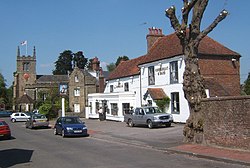Frant
| Frant | |
| Sussex | |
|---|---|
 Frant | |
| Location | |
| Grid reference: | TQ590354 |
| Location: | 51°5’47"N, 0°16’12"E |
| Data | |
| Population: | 1,645 (2011) |
| Post town: | Tunbridge Wells |
| Postcode: | TN3 |
| Dialling code: | 01892 |
| Local Government | |
| Council: | Wealden |
| Parliamentary constituency: |
Wealden |
| Website: | www.frant.info |
Frant is a village in Sussex, in the east of the county and just south of the Kentish border, which runs through Royal Tunbridge Wells, two miles to the north. It is in the county’s Rotherfield Hundred, in the Rape of Pevensey.
When the iron industry was at its height, much of the village was owned by ironmasters. Smuggling occurred here in the 17th and 18th centuries, and one of the turnpike roads (now the A267) came through here at that time.
The parish church is St Alban’s, and there is an associated church school.
There are three public houses in the parish: the Abergavenny Arms, the George Inn on the High Street and the Brecknock Arms at Bells Yew Green.
The village is served by Frant railway station, on the Hastings Line, in the hamlet of Bells Yew Green, just over a mile from the village.
Name
From the 12th century onwards Frant appears in charters and records, in as diverse spellings as Fernet, Fernthe, Fernth, Ferthe, Ferring, Vernthe, Franthe, Fraunte, Feruthe, Frenthe and Fant; these variations notwithstanding, the etymology of the name has its roots in the Anglo-Saxon meaning "place of the fern" or "place of the bracken", a reflection of the verdant countryside around the settlement.
History
The village is not mentioned in the Domesday Book of 1086, though it is accepted that a hamlet existed here before the Norman Conquest. Excavations in 1929 by S. E. Winbolt uncovered pottery fragments and iron-workings that indicated the presence of a settlement dating back to 100 BC. There is evidence that a pre-Norman road, with military posts, ran from Frant to Crowborough.[1]
The first mention of an area within the parish was in 742, when Æthelbert of Sussex granted the manor of Ridrefelde (Rotherfield) and Ramslye to the Abbey of St Denis in France; now swallowed into Royal Tunbridge Wells, Ramslye was at the time part of the parish of Frant.[1]
St Alban's Church in Frant was a major surveying point for the Anglo-French Survey (1784–1790) calculating the precise distance and relationship between the Paris Observatory and the Royal Greenwich Observatory, undertaken by General William Roy.
Geography
The village is at the northern edge of the High Weald, a ridge of hard sandstone that runs across the southern counties from Hampshire along the borders of Surrey, Sussex and Kent. The River Teise, a tributary of the Medway, runs through the parish.
The parish contains a number of designated Sites of Special Scientific Interest within. Eridge Park is a site of biological interest, consisting of park and ancient woodland, hosting a wide variety of flora and fauna.[2] The site encloses the National Trust reserve known as Nap Wood. Eridge Green is an area of ancient woodland with outcrops of sandstone that hosts some unusual fauna.[3] Another site is High Rocks, an area of geological interest due to the weathering patterns of the local sandstone.[4]
Outside links
| ("Wikimedia Commons" has material about Frant) |
References
- ↑ 1.0 1.1 Pearce, Luke (1912). Historical Associations of Frant. Tunbridge Wells: Pearce & Co.. p. 4. http://www.thesussexweald.org/bk.asp?BookId=frant12004&Xid=A&xnm=1.
- ↑ SSSI listing and designation for Eridge Park
- ↑ SSSI listing and designation for Eridge Green
- ↑ SSSI listing and designation for High Rocks
